Materials - Wood
Although less common in other parts of the world, wood use in residential construction is ubiquitous in the United States and Canada, for a number of very good reasons: In most of the regions it is relatively plentiful, it is easy to work with, it is durable when taken care of, and can be made to withstand earthquakes relatively easily. On the flip side of the coin, we have consumed our wood resources beyond their ability to grow back for so many years that we are now a major importer of wood. Politically, environmental groups, the government agencies, timber companies and other people affected by logging have been battling over what is reasonable for many years, and although it sometimes appears that both sides are coming to a reasonable compromise, it may be a long time yet before they actually agree on anything substantial.
As environmentalists, but also as wood users, a reasonable compromise is possible, and a key component of that is to reduce the overall demand for wood products by using them more carefully. We can no longer use any old growth, unless we are going to set aside land to regenerate whatever old growth we log off, and politically there seems to be no desire to do that: on the contrary there is pressure to continue to log the little bit that's left and convert it to rapid rotation forestry1. As designers and builders, we have to avoid specifying and buying unsustainably harvested wood, and the problem will then fix itself.
In the push to improve the way we manage our timber resources, a couple of programs have been created to sell wood that comes from better managed forests. The Forest Stewardship Council (FSC) is an independent, environmentally minded organization that acts as a third party certifier for companies that handle wood products. Under the FSC program, a forest owner pays to have their timber harvesting program inspected on a regular basis and receives a certification only if they meet FSC's fairly strict rules which are tailored to the climatic zone and specific ecology of the land in question. When a customer purchases FSC certified wood, not only has the timber harvest been certified sustainable, but everyone along the "chain of custody" who processes that wood has been certified as to their ability to accurately track certified and non-certified so that the customer knows they are buying certified wood.
To compete with FSC, the timber industry has their own program of self monitoring, but given the number of people in the industry with aggressive anti-environmental stances, it is not likely that many consumers will trust a system that is akin to the fox watching the chickens.2 The biggest failing of any of these programs is that sustainability is "forever" (or at least a very long time), and there is little to stop anyone from dropping out of the program, which in some ways invalidates any claim they've made in the past. Since the programs are relatively recent, and represent only a small portion of the wood cut every year, only the future will tell what effect these programs will have. No significant change will result until society as a whole assumes and demands that our forests be maintained sustainably, and rather than resorting to best case scenarios about what sustainable means for a particular parcel, companies will take the concept seriously and consumers will seriously punish those who don't.
Wood use in homes can be divided into three categories: framing lumber, of which the house is built out of, exterior finish lumber such as siding, roofing, casing, fascia, soffits and barge boards, and interior finish lumber, which includes flooring, cabinets and trim. There are a range of substitute products for both situations, and each has its own set of limitations. As with any other product, the key concepts are always "reduce, reuse, recycle".
Framing
Homes use a lot of lumber: according to NAHB the average house uses 13,127 board feet of framing lumber. One possible way to reduce wood use is to use an alternative building method to build walls, such as straw-bale or cob, but in each case there are complex tradeoffs, and actual wood use will depend on many factors (for a more complete discussion, see the construction section). Without taking any radical departures in building technique, there are a number of ways to use wood more efficiently in building.
Build small, simple structures
While building small will generally requires less wood use, the shape and
complexity of the structure is equally important (see
design for more info). Unless you do
framing layout on a computer, there is no easy way to compare the lumber use of
one design .vs. another.
Use only the minimum amount of wood
necessary to make the house structurally sound
This question has no easy answer, and certainly depends on the conditions you
want the house to be able to withstand: earthquakes, tornadoes, hurricanes, snow
loads and a room full of dancing people, being the most common. Local
building codes define a base level of structural integrity, but whether this
level is actually a good choice isn't as clear. The idea behind "advanced"
framing (circa 1980), was to give a set of framing techniques that reduced wood
use, increase energy efficiency all while preserving structural integrity.
For various reasons, its not clear how much those techniques are actually used.
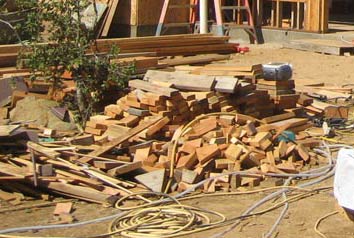
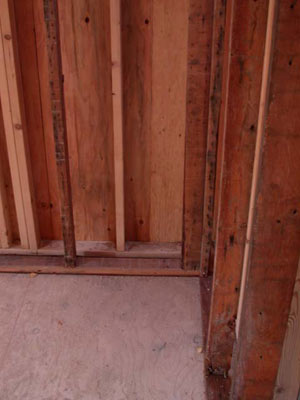
Minimize waste
Although some promote the idea of designing to take advantage of standard
lumber sizes, this is much easier said than done, especially in small houses
where every space is designed to be just the right size. One alternative is to
layout wood use so that a piece cut off one place can be mostly used some place
else. Since doing this is difficult, a second best system would be to keep piles
of cutoffs, and go looking in the pile every time you need a less than whole
piece. Of course, this involves extra effort on the framer's part, although some
simple strategies can help, like always going to the cutoff pile when you need a
piece of blocking. If it were cost effective to build wall panels off site
(like is done for roof trusses), then someone could layout the each wall panel
on a computer and the factory could not only reuse many of the cut off pieces,
but could potentially use the short pieces to make finger jointed wood on site.
Use reclaimed wood
Building departments won't let you use reclaimed wood for structural uses unless
its been graded by a certified inspector, but it can still be used for
non-structural uses, and that can be a lot of lumber.
Use engineered wood products
Engineered lumber uses smaller diameter pieces of wood glued together to
form a larger unit. In some cases the engineered component uses less wood
volume than the comparable solid wood component (TGIs), but in other cases it
doesn't (glu-lams). Many engineered wood products are made of small
dimension trees, which more closely matches the forest management strategies of
timber companies, but is not necessarily more environmentally friendly.
Some products, like particle board and finger-jointed lumber are made from the
waste from producing other wood products, and so increase the efficiency in
which the tree is used. Many builder have converted over to using
engineered lumber for a variety of non-environmental reasons: cost, product
availability, and comparable quality. The last issue is interesting,
because as old growth lumber disappears and smaller diameter trees are used, the
general quality of dimensional lumber has gone down, and problems with warping
have gone up. Engineered lumber products are made to be very straight and
stay that way. On a performance basis, engineered lumber compares very
well with comparable solid wood products and in most cases will not fail
any faster under extreme conditions (e.g. fire, rot), but there are clearly
exceptions.
Plywood & OSB
Plywood was one of the earliest forms of engineered lumber and was used
largely to replace 1x8 board sheathing and subflooring, and actually has far
superior shear stress properties than the wood it replaced. Unfortunately
plywood was originally made from old growth logs, and over time mills have
converted to using smaller logs. Plywood still requires somewhat larger
logs than OSB, because the logs are peeled to produce the layers that make up
the plywood, while OSB is made from small slices of wood that can come from very
small trees. Of course, just because younger trees can be used,
doesn't mean that the forest has been well managed, and in fact many have
accused the industry of doing just that. Even if OSB was a more
environmental product, some builders will not want to use it because it is more
vulnerable to water damage than plywood (apparently due to having more exposed
end grain, which soaks up water faster). The current state of affairs is
that most builders use OSB instead of plywood because it is cheaper.
Exterior Finish Lumber
Even if wood is not used for siding or roofing, there is still often a lot of exterior wood used, especially in a house with a "traditional" look. There are currently few or no alternative products for most of these applications.
Wood siding - although popular in the past, in most climates wood siding, whether the clapboard style, cedar shingles or panels like T-111 siding, will decay rapidly if not painted or stained, and requires frequent re-applications. For this reason, wood siding is not common any more. Louisiana-Pacific makes and engineered siding, usually called LP siding, which is just like OSB. In its original formula it was prone to moisture damage, and the result was a large class action lawsuit against the company. They now have a replacement product which they claim eliminates the problem of moisture damage (not verified).
Roofing - Cedar shake roofs are a traditional look in some regions of the country (in particular the pacific northwest), but due to decay have also become much less popular. Cedar is a limited and diminishing resource and many products are superior to it. Asphalt composition roofing is the most common product used.
Decks - While wood was always the product of choice, many people have turned to various plastic lumber products for decking (e.g. Trex), most of which are made out of recycled plastic bags. Since these products are inherently not structurally strong, the deck supports still need to be wood. Redwood, Cedar and various tropical hardwoods have been used, but unless they are specifically FSC, you're likely contributing toward the demise of rare species.
Interior Finish Lumber
In many ways wood is the perfect material for interior finish because it is easy to use and considered beautiful by many people. Because there is no structural requirement for finish lumber, a wider variety of wood products are suitable, including reclaimed and finger-jointed lumber. FSC certified flooring and other hardwood products is often available in a number of wood species.
Used lumber: most of this is old flooring, but other material, such as old bleacher boards, sections of bowling alley, redwood decking, barn lumber etc are sometimes available. Depending on what is on your building site, you may be able to reuse some of your own wood. Unfortunately there is no standard place to buy this material: typically its available thru a local green building supply or building materials reused store; some is also available on the web.
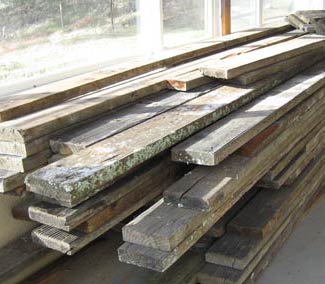
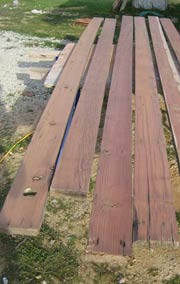
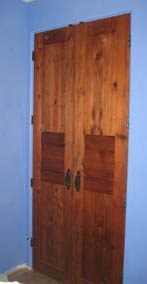
Used redwood decking: with nails removed (left), planned 2 sides (center), made into doors (right).
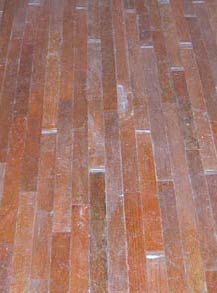
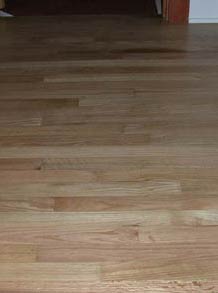
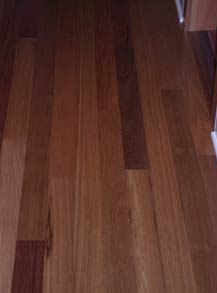
Re-used oak flooring in raw form (left), finished (center). Re-milled Australian hardwood
Re-milled lumber - larger old timbers are milled (often to your specification) into normal 1x and 5/4 material. Availability depends on a local supply of timbers, generally from the deconstruction of large old warehouses or similar buildings. Some of this wood is available as flooring, mostly from suppliers in the midwest.
Urban Salvage - trees cut down in urban areas are typically ground up, or otherwise wasted and hence urban salvage is when they are used for lumber instead. Because there are many non-native trees in urban areas, there is a wider variety of species available in urban salvage lumber. Many are hardwoods, but some softwoods are available also, depending on the region and supplier. Although the number of producers is growing, urban salvage is a small niche market, generally appealing to those looking for a unique product. This highly unfortunate as there are millions of board-feet of lumber removed from urban areas in the US every year.
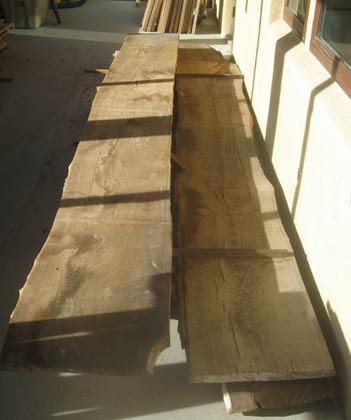
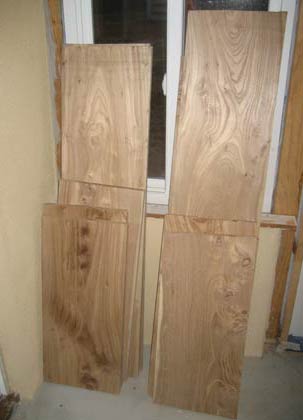
Urban salvage elm: slabs of tree (left), lumber (right).
Unlike standard hardwoods, its very typical for urban salvage wood to be sold as rough sawn slabs of tree, often still with bark on the edges (called "live edge"): you will have to cut it to size, and plane it smooth. Some suppliers will also sell wood that has been planed and or cut somewhat to size. The wood may either be air dried or be dried in a low-tech kiln, but in either case, unless you're very sure the wood is fully dry, the wood should be seasoned inside for 2-8 weeks. Although the logs are often acquired for free (other than choice logs of in-demand species like walnut), urban salvage producers don't have large equipment and the economy of scale that large producers do, so their costs per board foot are higher. However, if you're willing to take whatever comes out of the tree, they can give you extra lumber, as they often charge you only for the "usable" portion of the wood.
The advantage of buying raw wood is that often the slab of tree are much wider than you would ever be able to buy in the lumber yard--admittedly the wood might not be super flat, but depending on the length you need you likely can find flat sections. Since the wood is most likely plain-sawn, the slabs that come from the middle of the tree tend to be the flattest and those from the edges warp the most, although it all tend to bend around the center.
The major difficulty with using these trees for lumber is that they have to be removed in sizable chunks - 8 to 20 feet long in order to be usable, which increases the removal cost, but then a sizable portion of the disposal fees are avoided.
Particle board/MDF/MDO - composed of sawdust and glue pressed together with glue, these products make use of a waste product (sawdust) and so have some environmental appeal. Unfortunately most particle board uses Urea formaldehyde glue ("interior glue"), which off-gases formaldehyde for many years. Recent innovations in Europe have found additives that force the Urea Formaldehyde glue to off-gas quickly, which is necessary to meet the European E1 standard for formaldehyde emissions.
Medium Density Fiberboard (MDF) is a particle board that has more glue in it, and so is one of the worst offenders for off gassing when you buy "interior" grade. Select a MDF that is exterior grade, or is sold as a low VOC product (for example Medex and Medite). MDF is also a common building product, used mostly in finish trim.
Strawboard, made out of compressed straw is available as a replacement for particle board. Strawboard typically is made with little or no glue since the lignin in the straw will bind together when subjected to heat and pressure. Most strawboard is also covered in a melamine veneer, which is derived from petrochemicals (toxicity of manufacture?). A better option is to find a strawboard that is covered in a wood veneer. Straw is a waste product from growing grains and is very plentiful, although virtually all grains are grown using petrochemical based fertilizers.3
Notes
1: there is a movement toward specifying larger diameter (ie 4x4, 4x6 etc) FSC certified wood in order to create a market for it.
2: the SFI program has made great attempts to market itself as an equal to FSC.
3: whether or not straw is truly a waste product is a bone of contention, as organic farmers tend to plow their crop residue under to keep the soil organic matter up. I've been told that rice straw doesn't decompose well, but I've not verified it.
